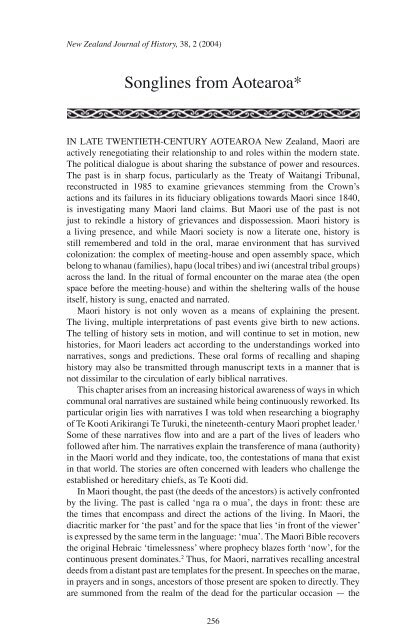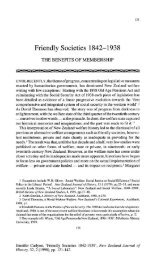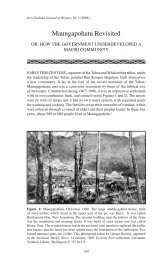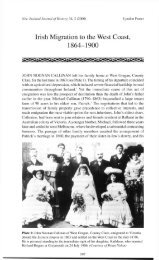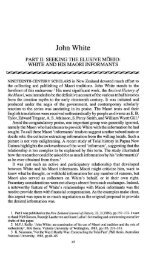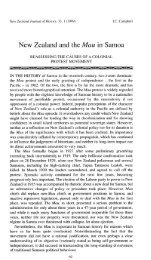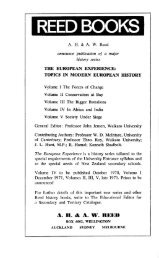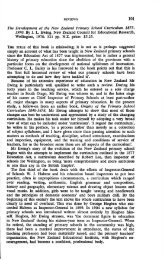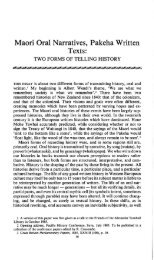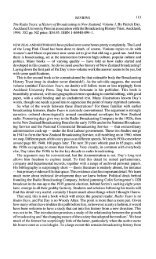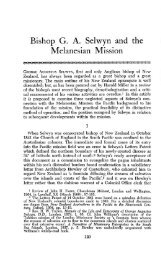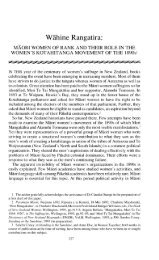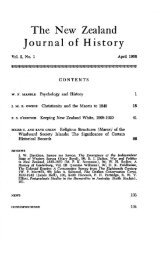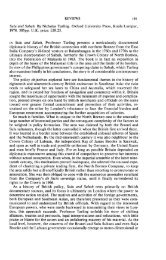Songlines from Aotearoa* - New Zealand Journal of History
Songlines from Aotearoa* - New Zealand Journal of History
Songlines from Aotearoa* - New Zealand Journal of History
Create successful ePaper yourself
Turn your PDF publications into a flip-book with our unique Google optimized e-Paper software.
<strong>New</strong> <strong>Zealand</strong> <strong>Journal</strong> <strong>of</strong> <strong>History</strong>, 38, 2 (2004)<br />
<strong>Songlines</strong> <strong>from</strong> <strong>Aotearoa*</strong><br />
IN LATE TWENTIETH-CENTURY AOTEAROA <strong>New</strong> <strong>Zealand</strong>, Maori are<br />
actively renegotiating their relationship to and roles within the modern state.<br />
The political dialogue is about sharing the substance <strong>of</strong> power and resources.<br />
The past is in sharp focus, particularly as the Treaty <strong>of</strong> Waitangi Tribunal,<br />
reconstructed in 1985 to examine grievances stemming <strong>from</strong> the Crown’s<br />
actions and its failures in its fiduciary obligations towards Maori since 1840,<br />
is investigating many Maori land claims. But Maori use <strong>of</strong> the past is not<br />
just to rekindle a history <strong>of</strong> grievances and dispossession. Maori history is<br />
a living presence, and while Maori society is now a literate one, history is<br />
still remembered and told in the oral, marae environment that has survived<br />
colonization: the complex <strong>of</strong> meeting-house and open assembly space, which<br />
belong to whanau (families), hapu (local tribes) and iwi (ancestral tribal groups)<br />
across the land. In the ritual <strong>of</strong> formal encounter on the marae atea (the open<br />
space before the meeting-house) and within the sheltering walls <strong>of</strong> the house<br />
itself, history is sung, enacted and narrated.<br />
Maori history is not only woven as a means <strong>of</strong> explaining the present.<br />
The living, multiple interpretations <strong>of</strong> past events give birth to new actions.<br />
The telling <strong>of</strong> history sets in motion, and will continue to set in motion, new<br />
histories, for Maori leaders act according to the understandings worked into<br />
narratives, songs and predictions. These oral forms <strong>of</strong> recalling and shaping<br />
history may also be transmitted through manuscript texts in a manner that is<br />
not dissimilar to the circulation <strong>of</strong> early biblical narratives.<br />
This chapter arises <strong>from</strong> an increasing historical awareness <strong>of</strong> ways in which<br />
communal oral narratives are sustained while being continuously reworked. Its<br />
particular origin lies with narratives I was told when researching a biography<br />
<strong>of</strong> Te Kooti Arikirangi Te Turuki, the nineteenth-century Maori prophet leader. 1<br />
Some <strong>of</strong> these narratives flow into and are a part <strong>of</strong> the lives <strong>of</strong> leaders who<br />
followed after him. The narratives explain the transference <strong>of</strong> mana (authority)<br />
in the Maori world and they indicate, too, the contestations <strong>of</strong> mana that exist<br />
in that world. The stories are <strong>of</strong>ten concerned with leaders who challenge the<br />
established or hereditary chiefs, as Te Kooti did.<br />
In Maori thought, the past (the deeds <strong>of</strong> the ancestors) is actively confronted<br />
by the living. The past is called ‘nga ra o mua’, the days in front: these are<br />
the times that encompass and direct the actions <strong>of</strong> the living. In Maori, the<br />
diacritic marker for ‘the past’ and for the space that lies ‘in front <strong>of</strong> the viewer’<br />
is expressed by the same term in the language: ‘mua’. The Maori Bible recovers<br />
the original Hebraic ‘timelessness’ where prophecy blazes forth ‘now’, for the<br />
continuous present dominates. 2 Thus, for Maori, narratives recalling ancestral<br />
deeds <strong>from</strong> a distant past are templates for the present. In speeches on the marae,<br />
in prayers and in songs, ancestors <strong>of</strong> those present are spoken to directly. They<br />
are summoned <strong>from</strong> the realm <strong>of</strong> the dead for the particular occasion — the<br />
256
SONGLINES FROM AOTEAROA 257<br />
opening <strong>of</strong> a new meeting-house, the launching <strong>of</strong> a canoe, or the negotiation<br />
<strong>of</strong> trusteeship for taonga (valued resources). In the karakia (prayers) used for<br />
lifting the tapu (controlling restrictions) <strong>from</strong> a new meeting-house, chiefly<br />
leaders <strong>of</strong> the past are called upon to awaken.<br />
Leading Maori figures <strong>of</strong> the nineteenth and twentieth centuries shaped and<br />
reshaped oral narratives concerning the transference <strong>of</strong> mana to the living. In<br />
the 1940s, for example, a Ngai Tahu elder <strong>from</strong> the South Island, Te Ari Pitama,<br />
depicted the decision <strong>of</strong> a nineteenth-century North Island tohunga (religious<br />
leader or priest), Hamiona Turoa, to divide his power: ‘Endowed with the<br />
mystic powers over life and death, he [Hamiona] was strongly insulated with<br />
the power <strong>of</strong> Tapu. His exemplary way <strong>of</strong> life was Christlike. Cognisant <strong>of</strong><br />
the fact that if his work for the good <strong>of</strong> his people was to survive, then his<br />
mana must be such as to show to all other tohungas that his powers exceeded<br />
theirs . . . . When he realised that his last days were numbered he decided that<br />
his power should be borne by four people, and so four quarters were selected.’ 3<br />
Three <strong>of</strong> the four inheritors, the narrative states, passed their spiritual mantles<br />
to the visionary, Tahupotiki Wiremu Ratana, founder <strong>of</strong> the Ratana faith in the<br />
twentieth century. The three included Mere Rikiriki, Ratana’s aunt, who herself<br />
stood in a line <strong>of</strong> descent tracing <strong>from</strong> the famous nineteenth-century prophets<br />
Te Ua Haumene and Te Whiti-o-Rongomai. Ratana, in his turn, declared that<br />
he would divide himself into four: that is — as it is usually understood —<br />
he chose the four who would, commencing in 1932, capture the four Maori<br />
parliamentary seats. 4 In Te Ari’s narrative, however, Ratana had sought the last<br />
quarter in vain: the power entrusted by Hamiona to Mananui Te Rangi Hiwinui<br />
<strong>of</strong> Rangitane. Mananui’s spiritual inheritance had instead been ‘seized’ by<br />
his younger son, Mahuri Manawatu, when he bit, as his father lay dying, his<br />
father’s big toe —thus appropriating his knowledge. Further, Mahuri’s mother,<br />
who had once seemed to be barren, was blessed by another <strong>of</strong> the inheritors <strong>of</strong><br />
Hamiona’s power, thus giving birth to two sons and averting the catastrophe <strong>of</strong><br />
wharengaro, a house without issue. In this South Island oral narrative, the story<br />
<strong>of</strong> Mahuri’s seizure <strong>of</strong> mana visibly interconnects with narratives <strong>of</strong> the fear<br />
<strong>of</strong> the failure <strong>of</strong> their line. 5 Mahuri, who became the tohunga for his mother’s<br />
people at Christchurch, in turn blessed the chiefly leader <strong>of</strong> the city, Ropata<br />
Wahawaha Stirling, who died in August 1997. Two other ‘mighty totara’ trees<br />
also fell in the winter <strong>of</strong> 1997. For each <strong>of</strong> the three, narratives <strong>of</strong> inheritance<br />
<strong>of</strong> mana are already evolving. 6<br />
In Maori narratives time is <strong>of</strong>ten collapsed. The present is explained by<br />
actions that are construed as having occurred yesterday: the ancestors walk<br />
with the narrator; the narrator is hero. In the years after their colonization <strong>from</strong><br />
Europe, dissident Maori leaders all constructed narratives about the pillars<br />
<strong>of</strong> their authority. The same narratives were expanded and redirected by the<br />
next generation <strong>of</strong> leaders. All these stories are myth-narratives in that they are<br />
‘chronicles <strong>of</strong> the impossible’. Yet they directly influence and shape political<br />
actions and judgements taken by the living in successive generations. Stories<br />
like Te Ari’s lie behind every one <strong>of</strong> the major Maori political movements <strong>of</strong> the<br />
nineteenth century, and they have engendered significant history in Aotearoa<br />
<strong>New</strong> <strong>Zealand</strong>.
258<br />
JUDITH BINNEY<br />
All Maori history is relational in that mana is transferred though the lines <strong>of</strong><br />
descent, or passed <strong>from</strong> one chosen person to another. In the nineteenth century,<br />
kinship was not necessarily the only path <strong>of</strong> inheritance to power: prediction,<br />
and accomplishment <strong>of</strong> prediction, <strong>of</strong>fered an alternative path. But the hau (the<br />
essence <strong>of</strong> life) in all cases was summoned into the present <strong>from</strong> the ancestors.<br />
In this sense, ancestral authority, no matter how it was transferred or seized,<br />
remained crucial to each successive leader.<br />
Three East Coast nineteenth-century leaders <strong>of</strong> very different political styles<br />
traced their descent <strong>from</strong> the same matakite (visionary), Toiroa Ikariki (Ikarihi).<br />
Toiroa lived at Nukutaurua on the Mahia Peninsula in the early nineteenth<br />
century, and Nukutaurua is famous in East Coast traditions as the final landing<br />
place <strong>of</strong> the Takitimu canoe, <strong>from</strong> which Kahungunu and Rongowhakaata,<br />
the two eponymous ancestors <strong>of</strong> major East Coast tribes, took their descent.<br />
Toiroa himself claimed descent <strong>from</strong> Nga-Toro-i-Rangi, the great tohunga<br />
<strong>of</strong> the founding Arawa canoe who called up the fires within the icy volcano,<br />
Tongariro. In the narrative account recorded by the nineteenth-century prophet<br />
leader Te Kooti he stated: ‘Na ko ahau (Te Kooti) te kai whakaatu i matakitetia<br />
mai ai e ia, a ki te whanau ahau ka tae mai he iwi hou ki tenei motu. He Atua<br />
ano to ratau, ara ko Tama-i-rorokutia he Atua pai otira ka ngaro te tangata/Now<br />
I (Te Kooti) was the one to reveal what he [Toiroa] prophesied, that when I was<br />
born a new people would come to this land. They would have another God, that<br />
is Tama-i-rorokutia (Son-who-was-killed), a good God, however the people<br />
would be oppressed.’ 7 This version <strong>of</strong> the narrative <strong>of</strong> Toiroa is a foundational<br />
text for Te Kooti’s vision, designed to assert a continuity between the new<br />
prophecy and the old. While the narrative evokes the colonial predicament <strong>of</strong><br />
Maori, it also anticipates that hope might be derived <strong>from</strong> the new religious<br />
teachings. It indicates that Te Kooti would be the leader for the people in<br />
their greatest time <strong>of</strong> trouble. Two other contemporary East Coast leaders<br />
attributed their legitimacy, and in one case his actual survival, to Toiroa.<br />
Hamiora Mangakahia, who became the first premier <strong>of</strong> Te Kotahitanga, the<br />
separate Maori ‘parliament’ <strong>of</strong> 1892, considered that he had been chosen to<br />
fulfil Toiroa’s quest for peace. This, Hamiora said, Toiroa had called for in<br />
1858 — on the eve <strong>of</strong> the colonial wars, and nine years before Toiroa died in<br />
the midst <strong>of</strong> the strife he had foreseen. In 1898 Hamiora quoted a prediction<br />
<strong>of</strong> Toiroa that it would be the ‘distant descendant’ (‘te Miha’) who would, one<br />
day, bring peace, 8 implicitly applying this description to himself. In his turn,<br />
Ihaka Whaanga, senior chief <strong>of</strong> Mahia and Nuhaka, who led war-parties in the<br />
government’s sweep against Te Kooti in the late 1860s, attributed his survival<br />
as a small child to a premonition <strong>of</strong> Toiroa, followed by his direct inter-vention.<br />
Toiroa rescued him, the potiki (littlest) <strong>of</strong> six children (a descriptive template<br />
derived <strong>from</strong> the widely known Maui myth-cycle), <strong>from</strong> a canoe, just before<br />
his father and all his own siblings were betrayed and killed by kinsmen. 9<br />
Toiroa was consulted widely on the East Coast during the 1850s and early<br />
1860s. When times <strong>of</strong> great significance approached, as these years certainly<br />
were, tohunga <strong>from</strong> different parts said, ‘it is the time <strong>of</strong> Toiroa’, and journeyed<br />
to Nukutaurua to seek his predictive wisdom. 10 It is still remembered <strong>of</strong> Toiroa<br />
that, when the spirit <strong>of</strong> prophecy entered him, he would assume the appearance
SONGLINES FROM AOTEAROA 259<br />
<strong>of</strong> the small brown lizard (papateretere), with his back arched and his fingers<br />
splayed: 11 the lizard is the sign <strong>of</strong> the person who belongs with the world <strong>of</strong> the<br />
spirits.<br />
Respectively Te Kooti, Hamiora and Ihaka told the story <strong>of</strong> themselves,<br />
establishing their direct link to Toiroa. In a similar fashion, indigenous leaders<br />
<strong>of</strong> the northern Andes, <strong>from</strong> the late seventeenth century to the 1980s, narrated<br />
events that established themselves and their legitimacy through their ‘descent’<br />
<strong>from</strong> earlier culture heroes. Don Juan Tama de Estrella <strong>of</strong> Páez, as an old man<br />
in 1708, narrated an account <strong>of</strong> the defeat and exile <strong>of</strong> neighbouring people<br />
as his own deeds (events that had occurred at least 75 years before he was<br />
born). Juan Tama is a mythic hero in twentieth-century Páez oral and written<br />
narratives, and is believed to inhabit the lake that now bears his name, appearing<br />
at times <strong>of</strong> great danger, such as La Violencia in the 1950s, to aid his people.<br />
He was born at a time when the Morning Star, Venus, was at its brightest and<br />
was, he said, ‘the son <strong>of</strong> the star <strong>of</strong> the Tama Stream’, that is, the local river<br />
into which little ‘stars’ fall when the water runs quickly at the June solstice. 12<br />
Thus, Estrella (Star) is the name he assumed in his own lifetime. Not only did<br />
Juan Tama telescope history in his narratives; he also projected his mythic<br />
image into the future, creating himself as divine emissary for his people. In<br />
the twentieth century, the activist leader <strong>of</strong> Páez, Manuel Qintín Lame, in turn,<br />
considered himself as the bearer <strong>of</strong> the inheritance <strong>of</strong> Juan Tama.<br />
Te Kooti Arikirangi and those who claimed to be his successor deployed<br />
history similarly. There were ancestral tasks and quests, which Te Kooti set<br />
and which his narratives revive; there were, and are, new tasks and quests<br />
that the later narrators set for future generations. The Tuhoe prophet Rua<br />
Kenana Hepetipa claimed his baptismal name Hepetipa (Hephzibah) in 1906<br />
<strong>from</strong> a prediction <strong>of</strong> Te Kooti’s uttered in 1885: ‘Te kupu whakaari mo te<br />
maungarongo . . . e ki nei ka karangatia koe ko Hepetipa, to whenua ko Peura,<br />
no te mea ka hua reka a lhoa i a koe, a ka whai tahu to whenua/The prophetic<br />
saying concerning the abiding peace . . . it says you shall be called Hephzibah<br />
and your land Beulah, for the Lord is well pleased with you, and your land<br />
shall have a spouse.’ 13 The scriptural text upon which this predictive message<br />
had been based was Isaiah 62:4, which looks to restoration <strong>of</strong> fruitfulness in<br />
the land. Rua was baptized as Hepetipa by Eria Raukura (Tutara-kauika), the<br />
senior tohunga <strong>of</strong> the Ringatu faith, which Te Kooti developed in exile. Eria<br />
baptized Rua in the flowing waters <strong>of</strong> the Waipaoa River, which courses down<br />
<strong>from</strong> the mountains into Poverty Bay, Te Kooti’s tribal area, to which he was<br />
never able to return. In taking this name Rua was stating that he was indeed<br />
the daughter <strong>of</strong> Zion. 14 The quests Rua undertook as prophet stem variously<br />
<strong>from</strong> tasks set by Te Kooti for his successor, <strong>from</strong> Rua’s own interpretations <strong>of</strong><br />
Tuhoe history, and <strong>from</strong> contemporary political events.<br />
As the aspirant but divisive leader <strong>of</strong> Tuhoe, the mountain people <strong>of</strong> the<br />
Urewera, Rua had to undertake encounters with the taniwha, the monsterguardians<br />
<strong>of</strong> their lands. In 1909, on a much photographed boating expedition<br />
on Waikaremoana, Tuhoe’s wild and beautiful lake, Rua ‘pacified’ Haumapuhia,<br />
the lake’s turbulent protector. According to traditional accounts, Haumapuhia<br />
was betrayed by her father and drowned there; her struggles to free herself
260<br />
JUDITH BINNEY<br />
created the wandering arms and channels <strong>of</strong> the great lake. She lies, face<br />
down, so that her mana will always return into the land, and her long hair<br />
ripples the lake’s waters. 15 The story <strong>of</strong> Haumapuhia ‘explains’ the lake, and<br />
constantly reminds <strong>of</strong> its dangers, for she is Tuhoe’s tipua (ancestral force)<br />
<strong>of</strong> hidden power. ‘Rua Tupua’, as Rua’s name was written in the East Coast<br />
dialectical variant on a flag made for him in 1906, went to Waikaremoana to<br />
wrestle with Haumapuhia — tapu against tapu, mana against mana. Rua’s son<br />
Heta described the contest between the tipua: ‘Haumapüpia boy isn’t it? — his<br />
grandfather, or something, killed him, dumped him in that lake. You can almost<br />
see the outline <strong>of</strong> him in that lake on a clear day, lying down flat. Taniwha is the<br />
Mäori [word], you know, water god. Well, if you do anything wrong, it don’t<br />
hesitate to kill you. It’ll drown you or do anything. ’Cause he [Rua] went to<br />
stop it, so it wouldn’t do any harm to anybody.’ 16<br />
Three years earlier, Rua had journeyed to Wairoa Harbour on a similar<br />
mission. Wairoa is within the tribal area <strong>of</strong> Kahungunu’s descendants, Rua’s<br />
father’s people. Rua was brought up in the region when a youth. He went to<br />
calm the taniwha who lies in the Wairoa Harbour. As Heta told the story:<br />
That one there is Hinenui-Te-Pö [Great Woman <strong>of</strong> Death], that’s a kuia [old woman],<br />
right in the middle <strong>of</strong> the harbour, the Wairoa Harbour. That is the reason, more or less,<br />
he went there, you know. To take that curse away <strong>from</strong> that. Nothing else. To stop that<br />
thing so nothing happened to his own people. He didn’t take very many people with<br />
him, only his apostles — his followers — about six or seven <strong>of</strong> them, I think. He just<br />
took the main people to do the service, and a few other things . . . I don’t know what<br />
year he went, but I think itís when he went to Pätütahi, you know, Rongopai. 17<br />
This visit to Wairoa took place in 1906. Rua was accompanied by about four<br />
men, who allowed themselves to be photographed with him. 18 Rua’s entry into<br />
the meeting-house Rongopai in March 1906 is also documented, but only the<br />
Maori oral narratives remember the purpose <strong>of</strong> that journey.<br />
For Rua, his entrance into Rongopai was a conscious reenactment <strong>of</strong><br />
myth-histories and, simultaneously, the completion <strong>of</strong> a contemporary quest.<br />
Rongopai was the great painted meeting-house built for Te Kooti in Poverty<br />
Bay in 1887. He himself never saw the house, as government intervention<br />
prevented him <strong>from</strong> returning home despite his pardon <strong>of</strong> 1883. The house,<br />
therefore, became extremely tapu, and it was closed by its guardians. Entry<br />
into Rongopai would be Rua’s public proclamation that he was Te Kooti’s<br />
predicted successor. Lying behind this quest are templates derived <strong>from</strong> and<br />
reflected in other great myth-histories: among them the ancient Polynesian<br />
cycle <strong>of</strong> the man-god Maui, the narratives <strong>of</strong> Tawhaki, the Wanderer, 19 and<br />
Ngai Tahu’s grim story <strong>of</strong> Tuahu-riri’s misdirected search for his father. These<br />
are all stories about claiming descent lines.<br />
Entry into the meeting-house usually represents the establishment <strong>of</strong> one’s<br />
ancestral lineage. The foundation myth tells <strong>of</strong> the hero, Maui, who fished up the<br />
first ancestral meeting house, together with the land/fish upon which it stood.<br />
There the narrative indicates unequivocally Maui’s transformation — <strong>from</strong> the<br />
troublesome youngest child — and his rebirth as man-god. 20 Tawhaki brought<br />
knowledge <strong>from</strong> the heavens back to this world, and is consequently seen as
SONGLINES FROM AOTEAROA 261<br />
the protector <strong>of</strong> tohunga. His second task was to recover his wife and daughter,<br />
whom he had lost by his own foolishness. He went disguised as an old man<br />
but was revealed by the flashing <strong>of</strong> lightening <strong>from</strong> his armpits; a power that is<br />
unique to him. As a result, at daybreak, the rear wall <strong>of</strong> the heavenly meeting<br />
house was broken open by his wife’s kinsfolk, so as to allow the child to go<br />
out into the world <strong>of</strong> light: Tawhaki picked up his daughter and began his first<br />
prayer, which led them outside. 21 Similarly, Tuahu-riri, when searching for his<br />
lost father, entered as a guest into the meeting-house and was there identified<br />
by his ‘kin’. He was then passed out through an opening in the back wall <strong>of</strong><br />
the house, because he, like Tawhaki’s daughter, was still in a state <strong>of</strong> tapu.<br />
However, Tuahu-riri failed to complete the tapu-lifting rites, as he refused to<br />
eat with his newly discovered ‘kin’. His rudeness and anger flowed <strong>from</strong> his<br />
realization that these people had originally intended to kill and eat him while<br />
welcoming him as their guest. The uncertainty <strong>of</strong> the claim that he belonged<br />
to this whanau is hinted at by his failure to complete the tohi (baptismal) rites.<br />
Tuahu-riri (The One-who-stood-angry-at-the-altar) would soon return to bring<br />
death to these people. 22<br />
Rua’s entry into Rongopai in 1906 belongs to this myth structuring. The<br />
narratives <strong>of</strong> the Iharaira (the Israelites, the followers <strong>of</strong> Rua, who are mostly<br />
Tuhoe people <strong>of</strong> the Urewera) state that Rua successfully claimed the house,<br />
the land and his descent as the ‘son’ <strong>of</strong> Te Kooti. Some versions tell how Rua<br />
entered the locked house by bursting through its rear wall. Similar stories are<br />
told <strong>of</strong> Te Kooti himself: at Koriniti, on the Whanganui River, for example,<br />
where the people had previously shown hostility to him, he is said to have burst<br />
violently through the back <strong>of</strong> the house, riding his white horse, and claimed<br />
space for himself and his faith in the centre aisle. 23 At Patutahi and Pakowhai<br />
in Poverty Bay, the local people had been similarly hostile, rejecting Rua’s<br />
claims. From the house Rongopai, it is told, Rua re-emerged through the door<br />
at the front, or variously, through the big front window. In every version <strong>of</strong> this<br />
narrative Rua is described as riding the white horse <strong>of</strong> Te Kooti. In the narrative<br />
sequences <strong>of</strong> Rua, the white horse is named Te Ia (The Crest <strong>of</strong> the Wave), and<br />
photographs exist <strong>of</strong> Rua and Te Ia <strong>from</strong> the period 1905–1906. Many <strong>of</strong> the<br />
stories state that it was Te Ia who gave Rua his entry into Rongopai. Tumeke<br />
Onekawa, who married Rua’s daughter Putiputi, told the narrative this way:<br />
‘He [Rua] was going to meet with Te Kooti at Rongopai. He got to Päköwhai<br />
— they never gave him the key to open the house. But his horse went straight<br />
in — and he had the key. Horse was in, and opened the door for Rua to come<br />
in. That’s how they knew. Because <strong>of</strong> Te Kooti. He said, “I’m going. My time<br />
is up. But my son is coming. You will find that son.” He was to go to Päköwhai.<br />
The horse had the golden key.’ 24 This narrative, which derived <strong>from</strong> Rua,<br />
emphasized the fulfilment <strong>of</strong> the quest.<br />
Two myth-templates most visibly underlie the actions <strong>of</strong> Te Kooti and<br />
Rua: further elements in Tawhaki’s tale, and the story <strong>of</strong> the marakihau (seacreature),<br />
Te Tahi-o-Te-Rangi, who succours his descendants. The Tawhaki<br />
cycle is widespread in Polynesia, and is particularly well known on the East<br />
Coast <strong>of</strong> the North Island, in the Urewera, and in the South Island, where<br />
descendants <strong>of</strong> Kahungunu migrated. Te Tahi-o-Te-Rangi seems to be particular
262<br />
JUDITH BINNEY<br />
to the Mataatua canoe tribes <strong>of</strong> the Bay <strong>of</strong> Plenty and the Urewera. I suggest<br />
that Te Kooti, at times, became Tawhaki, his ancestor. For, like Tawhaki, Te<br />
Kooti became the Wanderer, as he passed through the tribal boundaries <strong>of</strong> the<br />
nineteenth-century Maori world. He enacted crucial parts <strong>of</strong> the Tawhaki cycle,<br />
certainly in the later stages <strong>of</strong> his life.<br />
In 1867–1868, on Wharekauri (Chatham Island), Te Kooti was referred<br />
to by other Maori prisoners as Tawhaki, the twice-born, after his unexpected<br />
recovery <strong>from</strong> tubercular fever. Like this ancestor, he had been subject to the<br />
jealousy <strong>of</strong> his ‘brothers-in-law’, the Poverty Bay chiefs who had been, in part,<br />
instrumental in having him sent into exile. On the island, Te Kooti had been set<br />
aside in the house <strong>of</strong> death, his winding sheet prepared. 25 And like both Maui<br />
and Tawhaki he was reborn with a new role: to bring the prisoners home, and to<br />
give new life to the land. A narrative <strong>from</strong> 1878, when Te Kooti was sheltering<br />
with Ngati Maniapoto after the wars had ended, implicitly portrays Te Kooti as<br />
Tawhaki. Thrown out <strong>of</strong> a large gathering at Hikurangi, which had been called<br />
to negotiate with the governor and where Te Kooti had broken the ban that the<br />
Maori King, Tawhiao, had placed on alcohol, Te Kooti raged wildly through<br />
the night, while a tempestuous storm echoed his mood. At dawn, Te Kooti<br />
returned to his followers transformed: dressed in white albatross feathers,<br />
with only his face visible. He entered their meeting house like an old man,<br />
shuffling, coughing, and doubled over. When he reached the central sustaining<br />
post <strong>of</strong> the house, he stood with his head bowed, and told the assembled crowd<br />
that, although goodness belongs to humans they would inexorably corrupt it.<br />
Permanent peace was <strong>of</strong> God, not <strong>of</strong> humankind.<br />
Tawhaki is known as the master <strong>of</strong> disguises and was famous for his capacity<br />
to transform himself into a stumbling old man. When the lightening flashed<br />
<strong>from</strong> his armpits, however, he threw <strong>of</strong>f this disguise and asserted his power.<br />
In this story, Te Kooti is seen as Tawhaki, and his costume <strong>of</strong> albatross feathers<br />
visually depicts his message <strong>of</strong> divinely inspired peace. He was manifesting<br />
his pr<strong>of</strong>ound distrust <strong>of</strong> the earth-bound political negotiations taking place at<br />
Hikurangi.<br />
When Rua first claimed the mana <strong>from</strong> Te Kooti, he undertook a quest<br />
that took him to the summit <strong>of</strong> his mother’s tribal mountain, Maungapohatu.<br />
Here, according to the narratives, the hidden diamond on the mountain was<br />
revealed to him. This bright stone remains covered and protected by Te Kooti’s<br />
shawl (horo), just as Tane’s younger brother covered the bright stars with his<br />
mats (whara), before he gave the stars to Tane to create the skies. 26 In the<br />
Tuhoe narrative, Rua is the last to have seen the diamond on the mountain. It<br />
is sometimes said to be hidden within one <strong>of</strong> the three strangely coloured lakes<br />
on the mountain’s plateau, and in some versions the diamond was revealed to<br />
Rua by Whaitiri, the grandmother <strong>of</strong> Tawhaki, who is also ancestress <strong>of</strong> the<br />
Tuhoe people. In all versions, Rua encountered Whaitiri on the mountain’s<br />
summit. She is described, at first, as disguised in rags but revealing herself to<br />
be like ‘an angel’, possessing wings, and as ‘more or less Rua’s sister’. 27 This<br />
particular quest-narrative was already in circulation by 1905, that is, before<br />
Rua went to Rongopai. As Heta Rua consistently emphasized, it was after Rua<br />
saw the diamond, which Te Kooti had covered with his ‘rainbow shawl’, ‘that’s<br />
how he [Rua] started <strong>of</strong>f . . . . That’s when that gift was given to him.’ 28
SONGLINES FROM AOTEAROA 263<br />
This narrative implicitly identifies Rua with Tawhaki, who had travelled to<br />
heaven to meet Whaitiri. On his journey, Tawhaki entered one <strong>of</strong> the meeting<br />
houses <strong>of</strong> Ngahui Whatu, and there identified and recovered his father’s bones.<br />
Ngahui Whatu are the whatu kura, precious stones, who are the gathering<br />
<strong>of</strong> the stars, and the ancestors to whom Tawhaki prays. 29 The first karakia<br />
Tawhaki had been taught by Tama-i-waho in the highest heaven, to fix his new<br />
knowledge was Te Whatu, the Stone, and it is commonly said that Tawhaki<br />
brought back the first ‘whatu kura’ to humankind. 30 Whatu kura were used in<br />
the East Coast schools <strong>of</strong> learning to seal the scholars’ knowledge, and the tiny<br />
stones they had to search for, and swallow, were usually coloured red or white.<br />
On Wharekauri, in 1868, Te Kooti set the prisoners a riddle to resolve before<br />
their escape: how to eat a small white stone that he said had been revealed to<br />
him. The solution, to pound the stone and share it, bonded the prisoners and<br />
sealed their grasp <strong>of</strong> the escape plan.<br />
Diamonds, like the one revealed on Maungapohatu, are precious stones not<br />
found naturally in <strong>New</strong> <strong>Zealand</strong>. The story has several imaginative sources:<br />
one was quite possibly the North American Indian legend <strong>of</strong> the diamond<br />
hidden in their land, which had been retold by Nathaniel Hawthorne in 1851 as<br />
‘The Great Carbuncle’, and then widely circulated; another, I suggest, was the<br />
narrative <strong>of</strong> Tawhaki, who had encountered the whatu kura. In a version <strong>from</strong><br />
inland Poverty Bay, the Ringatu elder Ned Brown told the story <strong>of</strong> the portion<br />
<strong>of</strong> Te Kooti’s diamond, which Ned’s ancestor, Te Hira Uetuku, who had been<br />
a prisoner on Wharekauri, brought to his trib-al mountain, Maungahaumi, as<br />
a gift <strong>from</strong> Te Kooti. This was the mauri, the local guardian stone for the land<br />
and its people. In this version, Te Kooti’s diamond was shaped like the Lamb<br />
<strong>of</strong> God, ‘Te Reme’, and their portion was its foot (waewae), thus preserving<br />
their turangawaewae (footing). Ned then went on implicitly to connect the<br />
diamond with the large, glittering quartz-stone that used to be visible when<br />
the sun shone on the Mangatu River, whose several sources flow down <strong>from</strong><br />
Maungahaumi. The stone disappeared ‘when the Europeans started the wars’,<br />
but little white quartz pebbles, called the ‘children <strong>of</strong> Mangatu’, still tumbled<br />
in the river when it was clear — before the land was deforested and the river<br />
began to flood uncontrollably. 31 The little ‘glittering’ stones were like the stars<br />
<strong>of</strong> the Tama stream, and they existed before the environment was damaged<br />
by ‘prominent men’. This narrative <strong>of</strong> the river tells how ‘it once was’, and<br />
suggests also how ‘it should be’. The story is part <strong>of</strong> a system <strong>of</strong> knowledge<br />
that is particular and local, but which carries warnings <strong>of</strong> the dangers created<br />
through ignorance, corruption and greed.<br />
The story <strong>of</strong> Te Kooti’s diamond, hidden on the sacred mountains <strong>of</strong> each<br />
<strong>of</strong> the tribes who had sheltered him during the colonial wars, was given new<br />
life by Rua in 1905. In January <strong>of</strong> that year, the largest diamond in the world,<br />
the Cullinan diamond, was discovered in South Africa. The Boers called it<br />
‘God’s stone’, and after much public discussion, the parliament <strong>of</strong> the recently<br />
defeated Transvaal Republic voted, in 1907, to give it to King Edward VII<br />
as a state-ment <strong>of</strong> their loyalty. Rua, a regular reader <strong>of</strong> the Auckland Weekly<br />
<strong>New</strong>s, a popular photographic magazine, and who later papered the walls <strong>of</strong> his<br />
home and surrounding buildings at Maai with its pages, pre-empted the Boers
264<br />
JUDITH BINNEY<br />
by his own pilgrimage to Gisborne in 1906. His stated purpose was to meet<br />
King Edward. According to some narratives <strong>of</strong> this pilgrimage, which followed<br />
Rua’s successful entry into Rongopai, he carried with him a large diamond.<br />
Rua’s purpose was to ‘buy back’ <strong>New</strong> <strong>Zealand</strong> <strong>from</strong> the son <strong>of</strong> Victoria — to<br />
whom the land had been ‘given’ by treaty in 1840. It was to be a ritualized<br />
exchange in terms that Europeans could understand.<br />
On this journey, Rua took with him all the chiefs <strong>of</strong> Tuhoe and Ngati Awa<br />
<strong>from</strong> the eastern Bay <strong>of</strong> Plenty: 80 men. In so doing he was consciously<br />
fulfilling an earlier prediction <strong>of</strong> Te Kooti. In 1872, Tuhoe had formed their<br />
union <strong>of</strong> chiefs, Te Whitu Tekau, the Union <strong>of</strong> Seventy, as a shelter (tawharau)<br />
for themselves and their land. In a famous story that dates <strong>from</strong> March 1892, the<br />
Tuhoe chiefs asked Te Kooti to help them with the survey difficulties affecting<br />
their land ‘within the Shelter <strong>of</strong> Mataatua’ (‘ki roto i te Tawharau o Matatua’),<br />
‘that is, the Seventy’ (‘kia 70 tekau nga Tangata’). Te Kooti had replied:<br />
‘He Aitua he Tawhara he pouaru hoki — engari kia toopu, na ka whakaekea ki te 80 hei<br />
whakahaere mo nga raruraru. Ko Te Hurinui hei Tiaki.’ A oat-itia iho e Te Kooti taua<br />
whakahaere. Tu ana ia herea ana e ia tona tatua maurea ki te pou tokomanawa o taua<br />
whare.<br />
‘It was an Omen, an Odd number, a widow (a solitary branch left behind on a tree)<br />
— rather, when they do assemble, let the number be 80 to deal with the difficulties. Let<br />
Te Hurinui [Apanui] be the Guardian.’ The plan-ning was put under oath by Te Kooti.<br />
He stood up and tied his belt to the main post <strong>of</strong> that house. 32<br />
In this dramatic manner Te Kooti tied the tribes <strong>of</strong> the Mataatua canoe and<br />
the meeting-house together as one with himself. He also chose the leader to<br />
fulfil the new directive: Te Hurinui Apanui, chief <strong>of</strong> Ngati Awa who also had<br />
close kinship connections with Tuhoe, was to form the Eighty. Again, there are<br />
multiple layers <strong>of</strong> meaning encoded here. The original concept <strong>of</strong> the Union<br />
<strong>of</strong> Seventy derived <strong>from</strong> the Scriptures, for it was the number chosen for the<br />
elders <strong>of</strong> Israel, who were to accompany Moses and to whom God later gave<br />
‘the spirit’ when he lifted it <strong>from</strong> Moses. They then became the prophets, those<br />
with foresight. 33 In the <strong>New</strong> Testament, Christ appointed 70 to journey before<br />
him wherever he should go; the Tuhoe elder Mangere Teka explicitly drew this<br />
parallel when he discussed Rua’s 70 ‘police’, as he called them in his limited<br />
English. 34<br />
In Maori tradition, it is Tawhaki who brought to humans the knowledge<br />
that Whaitiri, his grandmother, invented: the skill <strong>of</strong> counting in lots <strong>of</strong> ten. 35<br />
Te Kooti’s task <strong>of</strong> completion, that is, adding ten to create the Eighty, has<br />
been interpreted in different ways. In June 1906, Rua himself chose to take 80<br />
men, among them Te Hurinui, to Gisborne, to fulfil Te Kooti’s instruction. 36<br />
Behind this action also lay the revelation Rua experienced on 12 April 1906<br />
(for the Ringatu faith, the twelfth <strong>of</strong> the month is the sacred day <strong>of</strong> the month,<br />
a practice that, at this time, Rua was still observing):
SONGLINES FROM AOTEAROA 265<br />
Maungapohatu, Aperira 12th 1906<br />
I tena ra ka whakaaturia; i [te] 25 o Hune haere au ki runga i te torona, ka tae mai a te<br />
kiingi ki Turanga.<br />
Maungapohatu, April 12th 1906<br />
On that day it was revealed; on June 25th I will ascend the throne, the king will arrive<br />
at Turanga [Gisborne]. 37<br />
This pilgrimage was reported by journalists and photographed for the Auckland<br />
Weekly <strong>New</strong>s. 38 The latent meaning <strong>of</strong> the, journey was then ascribed by Rua’s<br />
followers: instead <strong>of</strong> King Edward, who did not come to Gisborne, it was Rua<br />
who was properly king. It was a claim to sovereignty.<br />
Rua’s continuing relationship with Whaitiri extended at least into the late<br />
1920s. Whaitiri’s appearance was identified, in the Tawhaki myth cycle, by her<br />
unique perfume. 39 Heta Rua described Whaitiri’s presence, <strong>of</strong>ten experienced<br />
at Maungapohatu, in the same way:<br />
The only time you can notice her is she has a beautiful perfume. When Rua was passing<br />
you, you’d be trying to follow where it comes <strong>from</strong>. Well, it’s on him. That’s the only<br />
time you know that lady is there somewhere . . . . Once you get that perfume, she is<br />
there all right. That’s the only time when that lady appeared, when there’s a church<br />
service, or when he was going up to the pä in Maungapöhatuhe’s going ahead <strong>of</strong> you,<br />
then you get that perfume smell. It comes on the wind and you wonder where it is<br />
coming <strong>from</strong>. So that lady must be there, looking after somebody. 40<br />
Another ancestral figure with whom Rua identified was the sea-creature Te<br />
Tahi-o-Te-Rangi, who became famous for his saying that, rather than destroy<br />
people in revenge, ‘Waiho ma te whakama e patu. Waiho hai korero i a tatau<br />
kia atawhai ki te iwi/Leave them for shame to punish. Let us acquire fame<br />
by means <strong>of</strong> mercy.’ 41 Te Tahi appears on the porch <strong>of</strong> the carved house built<br />
by Tuhoe for Te Kooti, Te Whai-a-te-motu (The Pursuit-across-the-land). Te<br />
Kooti opened this house in 1891, and there could be little doubt that Rua was<br />
among the large gathering assembled to discuss the future <strong>of</strong> Tuhoe’s land.<br />
This principle <strong>of</strong> mercy, or tolerance, for which Te Tahi-o-Te-Rangi was<br />
remembered, Te Kooti had taken as his own when he eschewed war <strong>from</strong> 1873.<br />
Rua, in his turn, used his Tuhoe ancestral figure as his charter (or guide) when<br />
he adopted Te Kooti’s principle <strong>of</strong> maungarongo, lasting peace, and he had Te<br />
Tahi’s name stitched onto one <strong>of</strong> the flags he flew at Maungapohatu.<br />
There is, <strong>of</strong> course, another set <strong>of</strong> templates that all the Maori nineteenthcentury<br />
leaders applied to their own situation: the scriptural texts and stories.<br />
Maori internalized the redemptive messages <strong>of</strong> the Scriptures, as they<br />
identified with the genealogically structured, orally composed narratives <strong>of</strong><br />
the Bible, the Israelitic tribal traditions <strong>of</strong> journeying, and the Jewish history<br />
<strong>of</strong> dispossession. The identification strengthened rather than weakened as the<br />
situational parallels grew, once the confiscation <strong>of</strong> land was rammed through<br />
in all the regions where war was fomented by government actions <strong>from</strong> 1863.<br />
Each <strong>of</strong> the Maori prophet leaders saw themselves as Moses. Encoded in<br />
this identification is the premise that another leader would rise to fulfil the<br />
quest <strong>of</strong> Moses: to return the people to their homeland and to their autonomy.
266<br />
JUDITH BINNEY<br />
This template shaped many <strong>of</strong> Rua’s decisions. He called himself Moses, 42 and<br />
in the early years <strong>of</strong> his community at Maungapohatu the people tried to live<br />
by Mosaic codes:<br />
Ka whakaritea e ia i te wä i a Mohi ra ano . . . . Engari rawa to nohoanga whakamutunga<br />
nei na . . . ko te nohoanga nui tënei . . . i whakakorea ai te tapu ra, na, ki a Iharaira,<br />
ngä Riwaiti, ngä Iharaira katoa, ana, i tapahia ai ngä makawe-roroa . . . . Ae, kua mutu<br />
ngä tauira. Kua rnutu ngä tauira i whakaritea mai ai i te wä i a Mohi ra. Kua mutu ëra<br />
whakarite ki ana tängata makawe-roroa . . . . Engari i kï taku papa, ‘Ko ia tonu te Tapu,<br />
ko ia tonu te Noa.’ Ana ka kï ia me noa ia, ana, me te katoa rätau, ka noa katoa . . . .<br />
‘A, hoi ano’, kua kï, ‘hoki ia kua mutu. Kua rite tëra whakarite i te wä i a Mohi ma . . .<br />
a me hoki ano ki te tikanga tuatahi, a me whakapotopoto ngä makawe o rätau katoa ko<br />
ana tängata.’<br />
He likened it to the era <strong>of</strong> Moses . . . But the last sitting here . . . that was the biggest<br />
sitting [in 1915] . . . when the tapu was lifted, <strong>from</strong> Israel, <strong>from</strong> the Levites, all <strong>of</strong> the<br />
Israelites, and when their hair was cut . . . . Yes, the pattern was ended. The example<br />
set down had been achieved <strong>from</strong> the time <strong>of</strong> Moses. All those laws were finished with<br />
his long-haired people . . . . Rather, as my father [Tatu Horopapera] said, ‘He was the<br />
Sacred One, the Remover <strong>of</strong> Restrictions.’ When he [Rua] said the tapu was to be lifted<br />
<strong>from</strong> him and his people, so it was . . . ‘Oh, well’, he said, ‘it is finished. The things <strong>of</strong><br />
Moses’ time have been fulfilled . . . we must return to the original custom; we must all<br />
shorten our hair.’ 43<br />
These templates were, however, also modified by Maori cosmological<br />
principles. The whakanoa rituals, as described here, belong not merely to the<br />
transition <strong>from</strong> the times <strong>of</strong> the Old Testament to those <strong>of</strong> the <strong>New</strong>. They also<br />
pertain to the notion <strong>of</strong> being ‘clear’ or ‘cleansed’, the alternate state to living<br />
under the ‘restrictions’ <strong>of</strong> extended tapu, the rules by which the community<br />
had operated since 1907. The tapu-lifting rituals followed those <strong>of</strong> traditional<br />
hair-cutting rites for a child, the situation where ‘one tapu acknowledges the<br />
other’, allowing the restrictions to be lifted. 44 This new state <strong>of</strong> being, noa, has<br />
its own positive qualities. The name Maai, which Rua gave to his new home,<br />
built before his trial and imprisonment in 1916, affirmed these qualities. Maai<br />
means the very ‘clean’, or ‘clear’ place.<br />
In some versions <strong>of</strong> Rua’s entry into Rongopai, Christ awaited him inside<br />
the house, along with Te Kooti. But increasingly Rua came to identify himself<br />
with Christ; and Whaitiri was seen as his own ‘sister’ or female relative<br />
(tuahine). In 1915, when Rua was first imprisoned for the illicit sale <strong>of</strong> alcohol,<br />
to the intense irritation <strong>of</strong> the government, which had orchestrated his arrest,<br />
the sentence imposed upon him by the local magistrate proved to be countereffective:<br />
‘[H]is recent conviction and imprisonment, instead <strong>of</strong>, as was hoped,<br />
destroying his “mana”, will have the effect <strong>of</strong> adding to it as it is looked upon<br />
as the test <strong>of</strong> allegiance <strong>of</strong> his followers. Their usual remark is that “Christ was<br />
also persecuted”.’ 45 Rua’s second, and similarly orchestrated, arrest occurred<br />
in 1916. This time, armed police were sent, and two Maori youths (including<br />
one <strong>of</strong> Rua’s sons) were killed in the assault on Maungapohatu. The violent<br />
arrest <strong>of</strong> Rua and <strong>of</strong> his eldest son, Whatu, served, in the eyes <strong>of</strong> his followers,<br />
to affirm his identity as Christ: ‘They made Rua and his son dig their own
SONGLINES FROM AOTEAROA 267<br />
holes, three holes. The pits were to bury them, alive. They stand there, and<br />
Rua told the policemen, “Well, if you are going to put me to death, I want you<br />
people to shoot me, once. One shot. If you don’t kill me with one shot, that is<br />
to let you people know that I am the Son <strong>of</strong> the living God.” So they shoot him<br />
all right . . . . Well, he lived <strong>from</strong> that day, <strong>from</strong> 1916, right up to 1937. And<br />
no medical treatment; he only had the Mäori way.’ 46 Maori myth-narratives<br />
<strong>of</strong>ten focus on the transference <strong>of</strong> power to the next generation. Thus, they<br />
follow the general pattern <strong>of</strong> narratives about a son who claims his paternal,<br />
or maternal, lineage and who completes the unfinished tasks, just as Tawhaki<br />
identified, and recovered, his father’s lost bones. As Hirini Mead commented<br />
in his introduction to his recent retelling <strong>of</strong> the Tawhaki cycle, ‘Nowadays we<br />
think that sons should complete the tasks not finished by their fathers during<br />
their lifetime.’ 47 Mead thereby indicated, in simple form, the quest-formulae<br />
that have continued to evolve, seeking to address modern Maori concerns.<br />
Other succession narratives are couched as continuing quests, undertaken by<br />
rival claimants who each sought to prove that they were Te Kooti’s predicted<br />
successor. Between 1921 and 1923, Wi Raepuku (Ohana) undertook a series <strong>of</strong><br />
tasks to establish his claim that he had opened the ‘seven seals’ that he said had<br />
been laid on the land by Te Kooti. Wi Raepuku began his long journey <strong>from</strong><br />
Whanganui to Te Wainui, the land given to Te Kooti’s followers in the eastern<br />
Bay <strong>of</strong> Plenty, on 1 July 1921. On this date (one <strong>of</strong> the pillars <strong>of</strong> the Ringatu<br />
year), at Otoko marae on the Mangawhero river, Wi announced himself to be<br />
the predicted child <strong>of</strong> Te Kooti (‘te tamaiti a Te Kooti’). 48 The little meetinghouse<br />
at Otoko, called Tauakira, had been renamed by Te Kooti in 1891 ‘te<br />
Parakuihi’, the Breakfast, indicating its importance in the turn <strong>of</strong> his fortunes in<br />
the Whanganui district. He then span a riddle for the house, which Wi Raepuku<br />
set out to fulfil:<br />
Otoko . . .<br />
1. Tenei whare koTauakira, me hua e ahau ko te Parakuihi, a ka tina ahau ki konei.<br />
Otoko . . .<br />
1. This house is named Tauakira, but I shall name it the Breakfast, and I shall have<br />
dinner (repletion) here. 49<br />
Wi Raepuku led a pilgrimage <strong>of</strong> believers <strong>from</strong> Otoko through all the places<br />
associated with Te Kooti. They likened themselves to the children <strong>of</strong> Israel,<br />
‘nga tamariki a Iharaira’, just as Rua’s followers had done. Their journey took<br />
them through Kauangaroa and Karioi, along the Desert Road by the great<br />
snow-capped mountain Tongariro, <strong>from</strong> where Toiroa traced his descent, and to<br />
Whakatane in the eastern Bay <strong>of</strong> Plenty. At every spot they rested they planted<br />
trees to mark the stages <strong>of</strong> their pilgrimage. On 1 January 1923 (the first pillar<br />
<strong>of</strong> the Ringatu year), at Te Poroporo marae, Whakatane, Wi Raepuku claimed<br />
to have opened the ‘fourth seal’, Te Umutaoroa, or ‘the hangi (earth-oven)<br />
<strong>of</strong> long cooking’. Then, on the following 1 July he made the first <strong>of</strong> several<br />
unsuccessful attempts to exhume the bones <strong>of</strong> Te Kooti in order to take them<br />
back to Poverty Bay, Te Kooti’s birthplace. In this quest, to find the hidden<br />
bones <strong>of</strong> Te Kooti, which Wi Raepuku called the ‘sixth seal’, he failed.
268<br />
JUDITH BINNEY<br />
The stories and narratives that link the present to the past and <strong>from</strong> which<br />
Maori leaders have taken their guidance were not and are not static. Maori<br />
did not and do not live by rigid myth structures and ritual, inhibiting their<br />
capacity to respond to the unique or the unexpected. 50 Rather, oral narratives<br />
and metaphors, while sustaining historical memory, allow for an infinite variety<br />
<strong>of</strong> meaning and active response. The narratives change, and new philosophical<br />
frameworks can be incorporated, as the myth-narratives stemming <strong>from</strong> the<br />
scriptural texts — and the Auckland Weekly <strong>New</strong>s — demonstrate. Therefore,<br />
they continue to be told within local communities and on marae. The narrators<br />
hold the stories; the narrators may also be the main actors. The stories are<br />
brought forth to help make sense <strong>of</strong> their political decisions and to guide the<br />
choices they make. They are told so as to evaluate contemporary political,<br />
spiritual and cultural problems in the light <strong>of</strong> the people’s past experiences. If<br />
the stories hold a ‘sacred truth’, as Te Kooti and Rua believed they did, they are<br />
also ways by which those leaders came to understand contemporary problems<br />
and suggest choices <strong>of</strong> action for their people.<br />
During the three-month occupation <strong>of</strong> Pakaitore (Moutoa Gardens) at<br />
Wanganui in 1995, the leaders <strong>of</strong> the protest, both the rangatahi (the young<br />
men in charge <strong>of</strong> the temporary perimeter fence that had been erected around<br />
the two-acre public gardens) and the kaumatua, the elders, who came <strong>from</strong><br />
all the marae <strong>of</strong> the Whanganui River, variously spoke <strong>of</strong> the principles<br />
lying behind their actions. Niko Tangaroa, a Ringatu elder and former trade<br />
union leader, stated firmly that their ‘kaupapa’ (that is, the plan, the track,<br />
their purpose and their medium <strong>of</strong> communication with the divinity) was ‘the<br />
prophets’ themselves, whom he then named: Te Whiti-o-Rongomai, Tohu<br />
Kakahi, Titokowaru, Te Kooti and Rua Te Kenana, as he called him — Rua<br />
the Canaanite. 51 After an episode that occurred on 1 April, when police seized<br />
a young man for carrying a ‘hidden weapon’, the kaiwhakahaere (the leader <strong>of</strong><br />
the young men’s group for that day) reiterated the protesters’ commitment to<br />
peace. After a full-stepping wero (ritualized challenge), in which he evoked the<br />
hideous ngarara, the great lizard that circled over them, dropping down with<br />
monstrous claws, he gathered up the rakau, wooden sticks or batons that some<br />
<strong>of</strong> the rangatahi had worn in their belts. He carried the sticks into the meetinghouse,<br />
which had been built for the occupation, and ‘buried’ them all inside<br />
the house. The prayers that accompanied this lengthy ritual called for peace,<br />
rangimarie. The prophet evoked to support them was Te Whiti, who had led the<br />
passive resistance defending the lands <strong>of</strong> Parihaka in 1881. The tactics Te Whiti<br />
had adopted at Parihaka were analyzed later that night on the marae atea. It was<br />
generally understood that, in 1995 at Pakaitore, the police were using similar<br />
strategies — verbal abuse and piecemeal arrest — seeking to pick <strong>of</strong>f the young<br />
men and to provoke a broader response that would allow them the opportunity<br />
to retake this public space. Were the memories, or the narrative-metaphor <strong>of</strong><br />
the circling ngarara, or indeed the analysis <strong>of</strong> strategies inappropriate? I do<br />
not think so. Nor was the lengthy archival research that had been undertaken<br />
by the Whanganui River hapu to trace the history <strong>of</strong> the river and the trading<br />
reserve, formerly created for the tribes. And nor were the computers that had<br />
been brought into the tent-headquarters to link the protest and its purposes to<br />
the outside world.
SONGLINES FROM AOTEAROA 269<br />
In the winter <strong>of</strong> 1997, when the three tall totara fell, the candidates who might<br />
follow were discussed openly in terms <strong>of</strong> their whakapapa (genealogies) and<br />
their personal abilities. Their experiences range <strong>from</strong> activism to academia (as<br />
one would expect), but the mantles will pass on, and structurings <strong>from</strong> the past<br />
will be present in the stories. Spiritual power may be divided, for it might be<br />
feared, as Hamiona Turoa believed, that ‘no one was sufficiently insulated with<br />
tapu’ to carry on the work alone. 52 Mana may, however, be claimed tribally by<br />
one person through a series <strong>of</strong> actions, which will convey multivalent meanings<br />
to a watching Maori audience and will also be affected by that audience. The<br />
patterning <strong>of</strong> significance in the narratives is the knowledge <strong>of</strong> the past, which<br />
lies in front, woven onto the warp <strong>of</strong> the future that is unknown. The narratives<br />
transmit moral truths even as they are reworked in the hands <strong>of</strong> each and every<br />
narrator for their times.
270<br />
JUDITH BINNEY<br />
NOTES<br />
Originally published in Klaus Neumann, Nicholas Thomas and Hilary Ericksen, eds, Quicksands:<br />
Foundational Histories <strong>from</strong> Australia and Aotearoa, 1999. Republished with the permission <strong>of</strong><br />
the University <strong>of</strong> <strong>New</strong> South Wales Press.<br />
*I wish to express my gratitude to Te Maire Tau, Jane McRae and Angela Ballara for their<br />
generous advice.<br />
1 Judith Binney, Redemption Songs: A Life <strong>of</strong> Te Kooti Arikirangi Te Turuki, Auckland, 1995.<br />
2 George Steiner, ‘A Preface to the Hebrew Bible’, in No Passion Spent: Essays 1978–1996,<br />
London, 1996, p.58.<br />
3 Undated manuscript, Te Ari Pitama Manuscripts, private collection, Te Maire Tau,<br />
Christchurch.<br />
4 From 1868 until 1996 there were four seats in the lower house <strong>of</strong> Parliament for the Maori<br />
electorate.<br />
5 I am indebted to Te Maire Tau for oral knowledge surrounding the written text.<br />
6 ‘Nursery <strong>of</strong> the Mighty Totara’, <strong>New</strong> <strong>Zealand</strong> Herald (NZH), 9 August 1997; the Press,<br />
Christchurch, 12 August 1997; Mana, 18 (October–November 1997), p.9. The NZH article was<br />
written after the deaths <strong>of</strong> two leaders, Matiu Rata and Sir Hepi Te Heuheu, in late July; the<br />
Press’s article was written after Wahawaha Stirling’s death. Matiu Rata had held one <strong>of</strong> the Maori<br />
parliamentary seats for Ratana, until his resignation <strong>from</strong> the Labour Party in 1979. He was<br />
described by the president <strong>of</strong> the <strong>New</strong> <strong>Zealand</strong> Law Commission as a ‘Maori Moses’, who, as<br />
Minister <strong>of</strong> Maori Affairs, in 1975 created the act establishing the Waitangi Tribunal (NZH, 29 July<br />
1997).<br />
7 Manuscript notebooks compiled by Robert Biddle, secretary <strong>of</strong> the Haahi Ringatu (Ringatu<br />
Church), vol.1, 1927, p.239. Private collection.<br />
8 Hamiora Mangakahia, 10 May 1898, in Te Puke ki Hikurangi, 7 June 1898.<br />
9 Grace Smit, ‘Mana Maori: Questions <strong>of</strong> Authority on the East Coast During the Nineteenth<br />
Century’, MA thesis, University <strong>of</strong> Auckland, 1997, p.18.<br />
10 Bronwyn Elsmore, ‘Te Hahi o te Kotahitanga Marama (The Religion <strong>of</strong> the Reflection <strong>of</strong> the<br />
Moon)’, MPhil thesis, Massey University, Palmerston North, 1983, p.7.<br />
11 Oral Source (OS): Sir Monita Delamere <strong>of</strong> Te Whanau-a-Apanui, 14 December 1981,<br />
Opotiki.<br />
12 Joanne Rappaport, The Politics <strong>of</strong> Memory: Native Historical Interpretation in the Colombian<br />
Andes, Cambridge, 1990, pp.66, 72–73,141–2, 154.<br />
13 25 January 1885, Maungapohatu notebook 1880–1916, pp.90–91, MS C-22, Auckland<br />
University Library.<br />
14 For a fuller account <strong>of</strong> this prophecy, see Judith Binney, ‘Myth and Explanation in the<br />
Ringatu Tradition’, <strong>Journal</strong> <strong>of</strong> the Polynesian Society (JPS), 93 (1984), p.368.<br />
15 Elsdon Best, Tuhoe, Vol. One, 3rd ed., Wellington, 1977, pp.190–1, 978–80.<br />
16 OS: Heta Rua <strong>of</strong> Tuhoe, 23 May 1982, Whakatane. Haumapuhia is usually said to be<br />
female.<br />
17 OS: Heta Rua, 23 May 1982.<br />
18 See Judith Binney et al., Mihaia: The Prophet Rua Kenana and his Community at<br />
Maungapohatu, 4th ed., Auckland, 1996, p.27.<br />
19 John White, The Ancient <strong>History</strong> <strong>of</strong> the Maori, His Mythology and Traditions, Vol. One,<br />
Wellington, 1887, p.128 (English).<br />
20 See Agathe Thornton, ed., The Story <strong>of</strong> Mäui by Te Rangikaheke, Christchurch, 1992, p.25<br />
(Maori), p.50 (English).<br />
21 Hirini Moko Mead, Tāwhaki: The Deeds <strong>of</strong> a Demigod, Wellington, 1996, pp.73–75; White,<br />
Ancient <strong>History</strong>, Vol. One, p.118 (English), p.104 (Maori) (Ngai Tahu).<br />
22 For a version <strong>of</strong> this narrative, see Herries Beattie, Tikao Talks, Dunedin, 1939, pp.116–18. I<br />
am indebted to Te Maire Tau for details <strong>of</strong> the story <strong>of</strong> the eponymous ancestor <strong>of</strong> his hapu, Ngai<br />
Tuahuriri, and particularly the account <strong>of</strong> the incomplete hakari, which is omitted by Beattie.<br />
23 Binney, Redemption Songs, p.342.<br />
24 OS: Tumeke Onekawa, 10 December 1978, Kutarere.<br />
25 W. Leonard Williams, diary, 9 August 1868, typescript, Auckland Institute and Museum.<br />
26 See the story <strong>of</strong> Tane, who also created humankind, in Manu van Ballekom and Ray Harlow,<br />
eds, Te Waiatatanga mai o Te Atua: South Island Traditions Recorded by Matiaha Tiramōrehu,<br />
Christchurch, 1987, p.30.
SONGLINES FROM AOTEAROA 271<br />
27 OS: Heta Rua, 23 May 1982.<br />
28 OS: Heta Rua, 18 May 1978, Matahi; 23 May 1982.<br />
29 Based on the Ngai Tahu version in Te Waiatatanga mai o Te Atua, pp.39–40; but see also<br />
Mead, Tāwhaki, pp.32–36. In Bay <strong>of</strong> Islands traditions recorded in the early nineteenth century, the<br />
stars were said to be the left eyes <strong>of</strong> departed ancestors: Thomas Kendall, 11 March 1815, <strong>Journal</strong>,<br />
MS 55/12, Hocken Library, Dunedin.<br />
30 Mead, Tāwhaki, p.65; White, Ancient <strong>History</strong>, Vol. One, p.125 (English), p.112 (Maori);<br />
Margaret Orbell, The Illustrated Encylopaedia <strong>of</strong> Māori Myth and Legend, Christchurch, 1995,<br />
pp.194, 248.<br />
31 OS: Edward (Ned) Mokopuna Brown, 30 November 1983, Mangatu.<br />
32 Biddle manuscripts, Vol. Five, p.131.<br />
33 Exodus 24:1, 9–10; Numbers 11:16, 24–25.<br />
34 OS: Mangere Teka, 20 May 1978, Ruatahuna. The scriptural text is Luke 10:1, 17–19.<br />
35 Mead, Tāwhaki, p.49.<br />
36 Poverty Bay Herald (PBH), 28 June 1906; Royden <strong>New</strong>man, ‘Rua and his Followers Pass<br />
Through Ormond 1906’, typescript in the possession <strong>of</strong> the author.<br />
37 Wi Te Pou, diary, quoted in Jeffrey Sissons, Te Waimana: The Spring <strong>of</strong> Mana, Dunedin,<br />
1991, p.190.<br />
38 Auckland Weekly <strong>New</strong>s, 5 July 1906.<br />
39 Best, Tuhoe, Vol. One, p.908.<br />
40 OS: Heta Rua, 23 May 1982. Rua’s distinctive perfume had been noted by one journalist<br />
writing about 1908, who put it down to mere dandyism: ‘An odour <strong>of</strong> scent also emanates <strong>from</strong><br />
the Mehaia [sic], for, if King Louis was the First Gentleman <strong>of</strong> France, Rua is certainly the First<br />
Dandy <strong>of</strong> the Urewera.’ Undated clipping, Elsdon Best scrapbook M4, 34 , Alexander Turnbull<br />
Library (ATL), Wellington.<br />
41 Best, Tuhoe, Vol. One, 962. Translation by Best.<br />
42 PBH, 10 June 1907.<br />
43 OS: Te Puhi Tatu, 22 January 1978, Maungapohatu. Transcription and translation by Rangi<br />
Motu.<br />
44 Michael P. Shirres, Te Tangata: The Human Person, Auckland, 1997, pp.42–44; ‘Tapu’, JPS,<br />
91 (1982), pp.43–44.<br />
45 W.H. Bowler to Native Department, 13 June 1915, MA-MLPl, 1910/28/1, pt 2, Archives<br />
<strong>New</strong> <strong>Zealand</strong>, Wellington.<br />
46 OS: Mau Rua, son <strong>of</strong> Rua, 19 May 1978, Matahi.<br />
47 Mead, Tāwhaki, p.8.<br />
48 ‘Prediction <strong>of</strong> one to follow’, manuscript volume in the collection compiled by Frank Davis,<br />
Dossier on Te Kooti, vol.10, p.13, ATL.<br />
49 ‘Prediction <strong>of</strong> one to follow’, pp.8, 72 (slightly variant texts). Translation adapted <strong>from</strong><br />
Frank Davis.<br />
50 Yet this has been the interpretative framework created by the anthropologist Marshall Sahlins<br />
and the linguist Tzvetan Todorov, when writing about primarily oral cultures that experienced<br />
the dramatic arrival <strong>of</strong> European strangers in their land. Sahlins, in his Islands <strong>of</strong> <strong>History</strong>,<br />
Chicago, 1985, came dangerously close to arguing that Polynesians could perceive events only<br />
ritualistically.<br />
51 OS: Niko Tangaroa, 25 March 1995, Pakaitore. Kenana (Canaan) is usually stated as simply<br />
being Rua’s father’s given name, although <strong>of</strong> course it is scriptural in origin.<br />
52 Te Ari Pitama manuscript.


